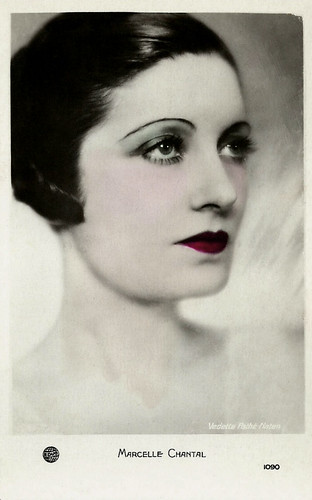
French postcard by EDUG, no. 1090. Photo: Pathé-Natan.
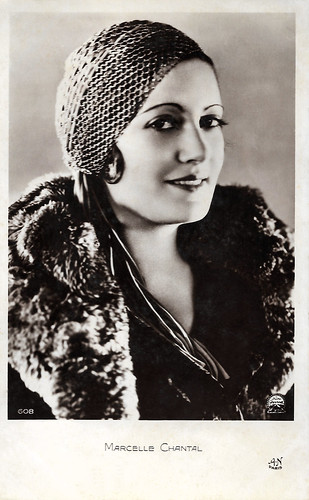
French postcard by A.N., 608. Photo: Paramount.

French postcard by A.N., Paris, no. 439. Photo: Engberg. Marcelle Chantal, aka Marcelle Jefferson-Cohn, as the Countess de la Motte in Le Collier de la reine/The Queen's Necklace (Tony Lekain, Gaston Ravel, 1929).
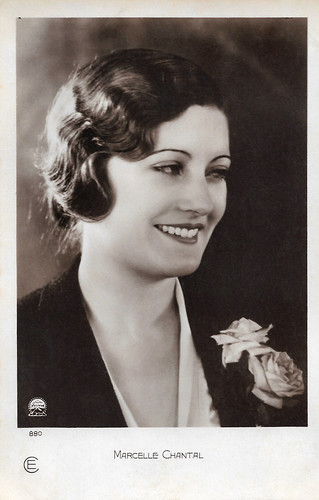
French postcard by Cinémagazine-Édition, Paris, no. 880. Photo: Paramount.
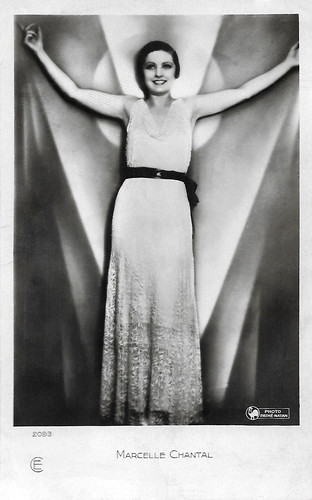
French postcard by Cinémagazine-Édition, Paris, no. 2093. Photo: Pathé-Natan.
Never a prima donna
Marcelle Chantal, sometimes known as Marcelle Favrel, was born Marcelle Chantal Pannier in Paris in 1901.
She came from a wealthy family of bankers and endured a severe education which included the arts. She discovered she liked singing and dancing, but her mother considered this improper. Director Marcel L’Herbier, a family friend, wanted her to debut in the film and let her take a screen test, but her mother forbade it.
After she married a rich and handsome American in 1921, David Jefferson-Cohn, her husband let her enjoy public life in Paris as a pastime, in particular the arts. And so, when they were still betrothed, Marcelle debuted in cinema in L’Herbier’s film Le Carnaval des vérités (Marcel L’Herbier, 1921).
After she had been applauded as a singer on charity galas, she took singing more seriously, first at the Opéra Comique in La Vie de bohème, then at the Opéra Garnier in Thaïs, under the name of Marcelle Jefferson Cohn. When she didn’t accept authority anymore, her husband hired her at the Théâtre des Champs Elysées, so that she could do as she pleased.
She took things seriously, collaborating with a.o. Firmin Gémier and introducing the beautiful dancer Anna Pavlova, but eventually her work as manager and singer took its toll, so for months she was ill. When she recovered she realised she would never become prima donna, and set her mind on another profession, though it took some years.
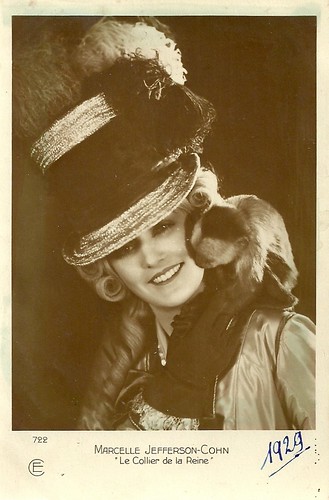
French postcard by Editions Cinémagazine, no. 722. Marcelle Chantal aka Marcelle Jefferson-Cohn in Le collier de la Reine/The Queen's Necklace (Gaston Ravel, Tony Lekain, 1929), inspired by Alexandre Dumas's tale.
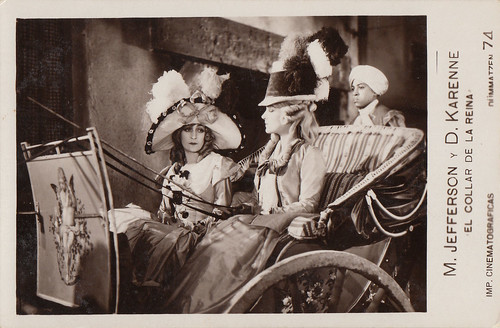
Spanish postcard by Dümmatzen, no. 74. Diana Karenne and Marcelle Jefferson-Cohn (a.k.a. Marcelle Chantal) in Le collier de la reine/The Queen's Necklace (Tony Lekain, Gaston Ravel, 1929). Collection: Marlene Pilaete.
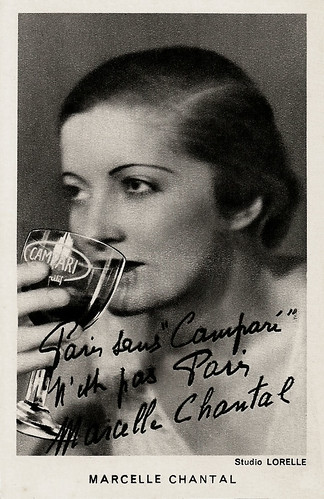
French postcard for Campari. Photo: Studio Lorelle. Caption: "Paris sans Campari, n'est pas Paris." (Paris without Campari is not Paris.)
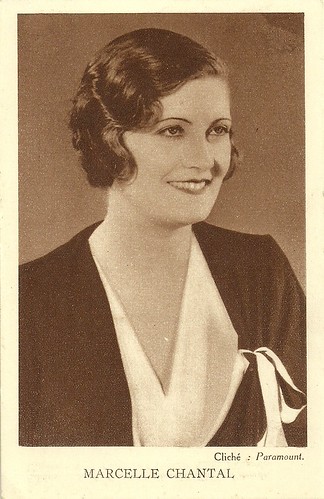
French postcard. Photo: Paramount.
Humour and elegance
In 1929, Pola Negri was supposed to play the plotting Comtesse de la Motte in the Gaumont-Franco Film-Aubert production L’Affaire du Collier de la Reine/The Queen’s Necklace (1929). This was an early French sound production directed by Gaston Ravel and Tony Lekain, friends of Chantal.
When the Polish diva made a scene and refused to play, Chantal immediately stepped forward and became a success. Her co-stars were former silent stars George Lannes (Cardinal de Rohan) and Diana Karenne (Marie Antoinette) and rising star Fernand Fabre (Comte de la Motte).
When Marcelle’s husband, however, made her understand that a hobby was alright but not a career, she made him understand their marriage was over. She was set on a film acting career. Until the outbreak of the Second World War, she would act in various French sound films, under the name of Marcelle Chantal, expressing humour and elegance. In two years’ time, she had already performed in eight films.
Chantal would act opposite many male stars of those years, such as Pierre Richard Wilm, Fernand Gravey, Jules Berry and Jean-Pierre Aumont.
After the female lead in La tendresse/Tenderness (André Hugon, 1930) with Jean Toulout, she was the female star of several French Paramount productions: Toute sa vie/All her life (Alberto Cavalcanti, 1930), Le secret du docteur/The Doctor's Secret (Charles de Rochefort, 1930) with Max Maxudian, La vagabonde/The Vagabond (Solange Térac, 1930) with Fernand Fabre, Le réquisitoire/Homicide (Dimitri Buchowetzki, 1931) again with Fabre, and Les vacances du diable/The Devil's Holiday (Alberto Cavalcanti, 1931) with Thomy Bourdelle.
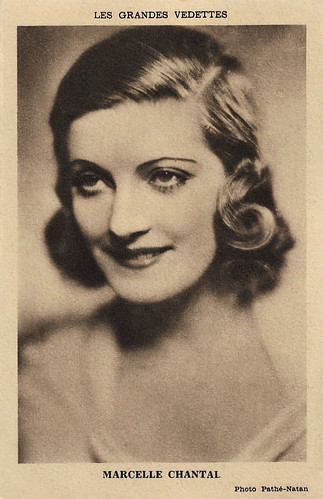
French postcard in the Les grandes vedettes series by Radiogravure A. Breger Frères, Paris, offered by L'Industrie Boutonnière, St. Maur-des-Fossés. Photo: Pathé-Natan.
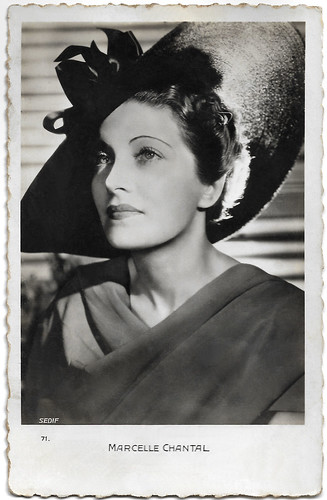
French postcard by Ed. Chantal, Paris, no. 71. Photo: Sedif.
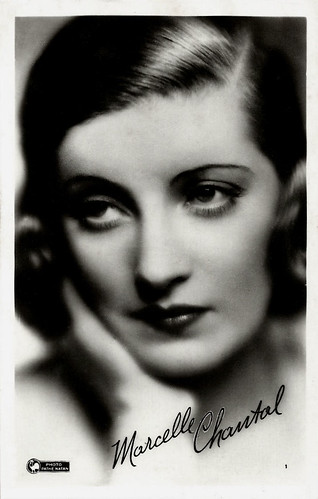
French postcard by Editions et Publications cinématographiques, no. 1. Photo: Pathé-Natan.
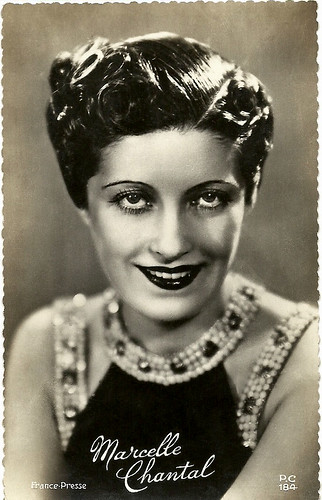
French postcard by PC, no. 184. Photo: France Presse. Collection: Didier Hanson.
A comeback against all odds
Marcelle Chantal then starred in films for various companies such as Pathé-Nathan: Au nom de la loi/In the Name of the Law (Maurice Tourneur, 1932) with Gabriel Gabrio, L’ordonnance/The Orderly (Viktor Tourjansky, 1933) with Jean Worms and Fernandel, Amok (Fyodor Otsep, 1934) with Jean Yonnel, Antonia, romance hongroise/Antonia (Jean Boyer, Max Neufeld, 1935) with Fernand Gravey, Baccara (Yves Mirande, 1935) with Lucien Baroux, and La gondole aux chimères/The Phantom Gondola (Augusto Genina, 1936) with Henri Rollan and filmed in Italy.
In 1936 she played opposite Victor Francen in L’Herbier’s La porte du large/The Great Temptation (Marcel L’Herbier, 1936), partly shot in Brest and Finistère. Chantal then acted opposite Harry Baur in Nitchevo (Jacques de Baroncelli, 1936). She went to London to star in A Romance in Flanders (Maurice Elvey, 1936) and subsequently acted in L’ile des veuves/The Island of Widows (Claude Heymann, 1937) with Pierre Renoir. In 1938 she starred as Tsarine Alexandra opposite Harry Baur as Rasputin in L’Herbier’s prestigious production La tragédie impériale/Rasputin. After this, she starred with Pierre Renoir in the court case drama L’affaire Lafargue/The Lafargue Case (Pierre Chenal, 1938).
Chantal’s last role before the war was in Jeunes filles en détresse/Girls in distress (Georg Wilhelm Pabst, 1939). The plot revolves around parents (Chantal and André Luguet) who are too busy working to take care of their daughter Jacqueline (Micheline Presle), so they send her to a boarding school, where all the girls prove to be children of divorced parents. When one girl attempts suicide and when Jacqueline’s parents decide to divorce as well, the girls are in crisis.
Outraged about the outbreak of the Second World War, Marcelle Chantal fled to Switzerland, where she toured the country with a theatre show and even dared to perform on the Côte d’Azur while the demarcation line was still running. When peace returned, Marcelle Chantal rediscovered that Paris had changed: the prewar divine creatures had become outdated, so her type and good manners were no longer assets. She tried a comeback against all odds, starring in Fantomas contre Fantomas (Robert Vernay, 1948-1949) with Aimé Clariond as Bréval and Alexandre Rignault as Juve. She also played Marianne in the Colette adaptation Julie de Carneilhan (Jacques Manuel, 1950) opposite Pierre Renoir, Edwige Feuillère and Jacques Dumesnil.
Fittingly Chantal closed her film career with the part of the ageing courtesan Léa de Lonval opposite Jean Dessailly in the title role in another Colette adaptation: Chéri (Pierre Billon, 1950). Just like Léa heartbroken accepts that Chéri abandoned her at the instigation of his mother (Jane Marken), and married a girl of his own age he doesn’t love, Chantal understood that times have changed. Marcelle Chantal left her beloved Paris and retired to an estate in the Pyla/Pilat, near the basin of Arcachon. She refused all subsequent proposals to return to the screen. Cancer was slowly disfiguring her beauty, so in her rare public appearances, she was heavily veiled. The illness took Marcelle Chantal away shortly after her 59th birthday in 1960.
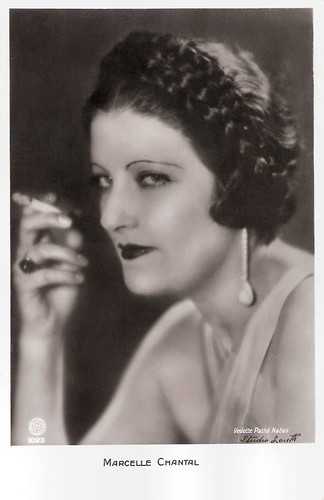
French postcard by EDUG, no. 1023. Photo: Studio Lorelle / Pathé Nathan.

French postcard by Editions O.P., Paris, no. 78. Photo: Teddy Piaz.
Scene from L’ordonnance/The Orderly (1933) with Marcelle Chantal at the piano. Source: Camille885 (YouTube).
Sources: Celine Colassin (Cinéartistes - French), Wikipedia (French) and IMDb.
This post was last updated on 16 September 2023.
No comments:
Post a Comment